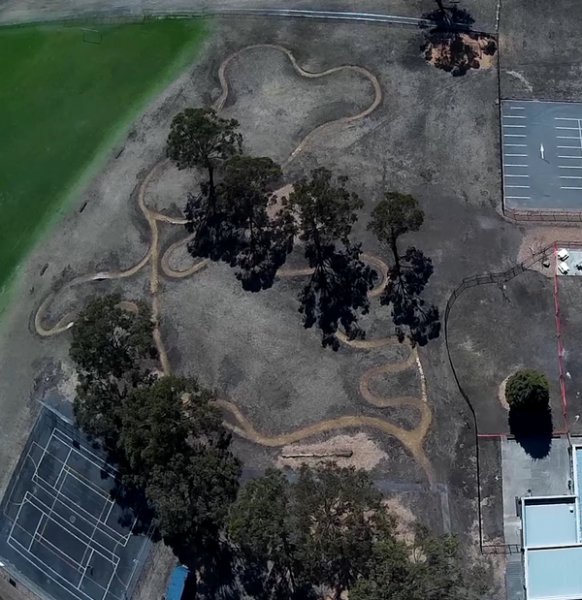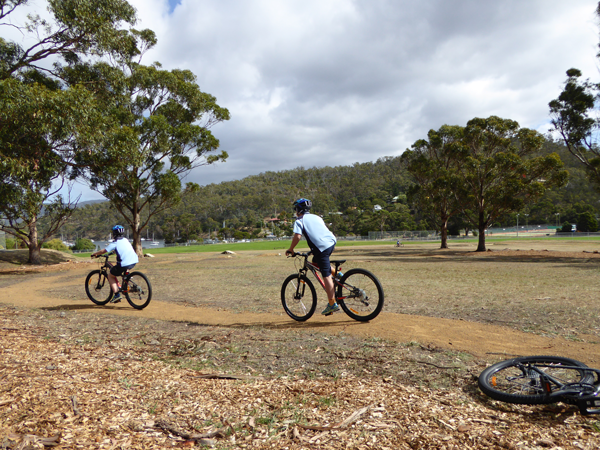Can a mountain bike track be a tool for teaching? A Tasmanian school is testing its new facility to the limits of utility. Simon Vincett reports.
A Hobart primary school is pioneering the use of bike riding as behavior modulation and a learning tool, with a mountain bike track as part of the playground. Used by students for lunchtime recreation, teachers are encouraged to use the facility for prepared lessons and the school bike fleet—kept for use on the track—will be maintained by students trained and supervised by professional mechanics.
Lindisfarne North Primary School principal, Shane Oldfield, says “We use it to get kids active—it’s not so much about rewarding them. It can be a good outlet for any kid to use some energy up. Some of our kids that are a lot more vocal and do a lot more movement in class benefit from getting out—and they’re showing their skill on the track and enjoying working with their peers.”
The track came about as a result of the school moving location this year. Oldfield explains: “We relocated the school from a very small site to a considerably larger one and part of the process was working with a landscape architect on different options for the playground. She put up the idea of the bike track.”
The idea was approved and the school engaged track-builders Dirt Art (builders of the Hollybank trails in north-eastern Tasmania) to create something appropriate for school children. The result is a 440m track with six features, including timber steps and a balance rail, that opened in March this year.
The school provides a fleet of 10 bikes and helmets for students to ride on the track and one adult bike and helmet for staff. “We figured using our bikes and our helmets we could control how often they’re maintained and how well they’re looked after,” says Oldfield. “We’ve set up a three-year cycle of purchasing and maintenance in a deal with Bike Ride (shop in Hobart) where they come out here and do maintain and help us out. It’s a longer term picture we wanted to look at rather than the immediate.”
Students are also prepared for riding the track. “Each class goes through a short education program on how to use it safely and then we have it on a rotation system where each class has time at lunch to use it,” Oldfield explains. “At the moment it’s for grades three to six but we’re going to expand it to add more grades. At any day we’ve got 10 kids riding and a few waiting, and then they swap over during the break. So most days maybe 15 or 20 kids will have a ride.”

There are 300 students at Lindisfarne North Primary School and Oldfield estimates about 20 ride to school per day: “A lot come in cars. Some walk—we’re part of the ‘part way is OK’ program and we encourage kids to walk. On most days, even when the weather is bad, we get 20 kids riding.”
A nearby highway with poor crossing options is a barrier to some kids riding to school. “But there are a lot of safe ways to ride to school,” says Olfield. “Kids of all ages are doing it—some with parents, some on their own. In general, the facilities for riding to school are pretty good in this area.”
Bicycle Network’s infrastructure advocate in Hobart, Emma Pharo, congratulates the school for assisting its students getting more physical activity: “It’s great to see schools being proactive. Lindisfarne North Primary is in an excellent position to be encouraging kids to walk and ride. They are adjacent to the Clarence Foreshore Trail, which is one of the few off-road, shared paths in Hobart, and there are many quiet residential streets around the school.”
“Riding and walking to school is a great way to carve out physical activity time without cutting into a packed school curriculum,” says Pharo. “We would like to see Ride2School being funded in Tasmania, so that more schools are supported to take the next steps in getting their kids more active. Bicycle Network’s Ride2School program is flexible in what those next steps are, because the road context, students’ home location, classroom opportunities and teacher involvement are different for each school.”
We’re about to start a group of kids to be in charge of maintaining the bikes, so they’re going to learn that component of it as well, and teach their peers.
Shane Oldfield has plans for more bike-based activities at the school: “Expanding what we’re doing around bikes is really important to us—to keep it moving. We’ve spoken about a ‘bike ed’ program about riding on the roads. We’re about to start a group of kids to be in charge of maintaining the bikes, so they’re going to learn that component of it as well, and teach their peers.”
Oldfield also sees potential in the track as a teaching tool: “We’re encouraging classes that want to use it during classtime for prepared lessons. We’re willing to look at any way we can to use the resource.”
“We don’t want to over-engineer it—we want to see how it evolves and see what kids get out of it and go from there,” he says.
The track is also providing a facility for the local community, which the school encourages. “I’ve been here on the weekend and almost every weekend there are community members using it,” says Oldfield. “We really encourage that. We’ve got parents bringing their kids as well as people from the community who have nothing to do with the school practising skills there.
Ride On content is editorially independent, but is supported financially by members of Bicycle Network. If you enjoy our articles and want to support the future publication of high-quality content, please consider helping out by becoming a member.


Our primary school has a bike track in our neighbouring bushland. We open it two lunchtimes per week. It’s very popular. The school has accumulated nearly 100 bikes and some kids bring their own. Kids from Prep to Grade 6 access this facility.
John Morton
Assistant Principal
Eaglehawk North Primary School Victoria
Dirt art built Hollybank in the NE of Tasmania NOT Derby, that was constructed by World trails.
Bikes and riding tracks in schools has had a huge impact on student’s wellbeing and learning in New Zealand as part of the successful Bikes in Schools program. So far the Bikes in Schools programme has helped over 35 schools with a package of bikes, helmets, bike tracks and cycling lessons.
This has got over 8,000 school children onto bikes on a regular basis at school.
It’s great to see Australian schools beginning to implement riding tracks as well!